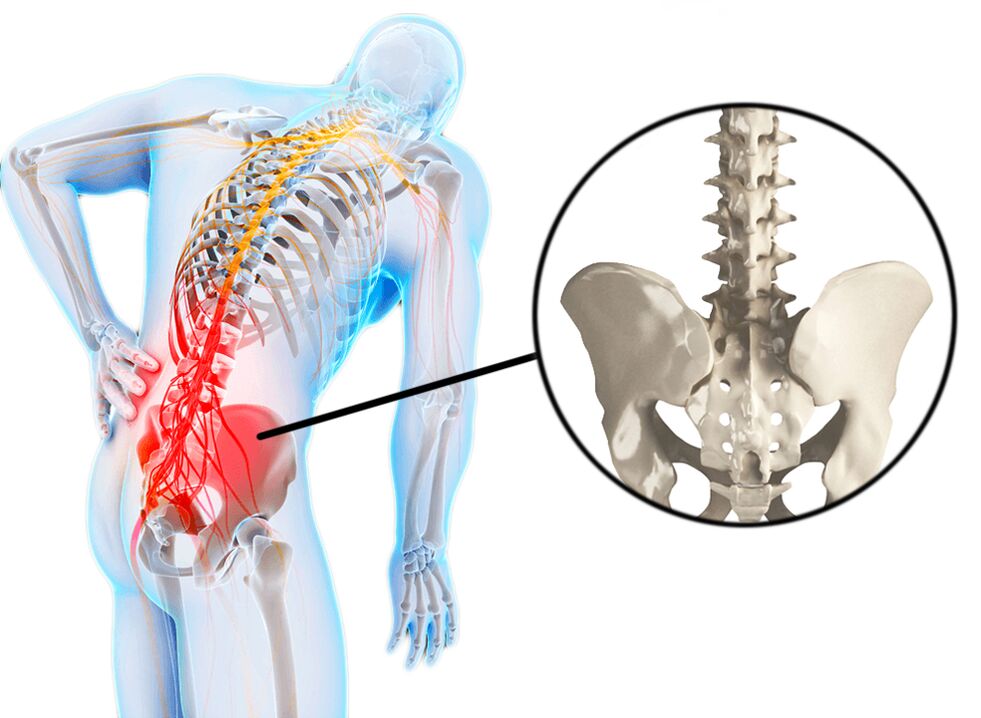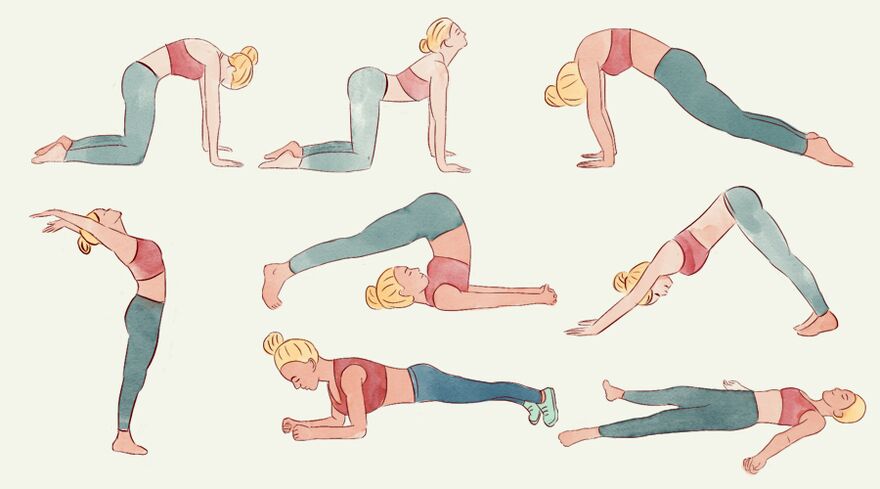
Low back pain is often referred to as lumbago or lumbodynia. Lumbago or "lumbago" is a bout of acute low back pain that is usually associated with hypothermia and exertion. Lumbago occurs in many people and is often the cause of temporary disability. Often, sports injuries or sprains can be the cause of lumbago, but sometimes the factor that causes the incidence of pain is unknown. Lumbago is characterized by pain without radiating to the legs. Low back pain (lumbago) can occur acutely and gradually develop during the day. Often there is stiffness in the morning and eventually the stiffness turns into pain syndrome. Curvature of the spine (numerical scoliosis) is also possible due to muscle spasms. The pain itself can be caused by muscle spasms, which in turn are related to other causes. This can be congestion or sprain, sports injuries, herniated discs, spondyloarthrosis (spondylosis), kidney disease (infections or kidney stones). Sometimes the patient accurately determines the cause-and-effect relationship to the appearance of malaise with exertion, hypothermia, but often pain occurs for no apparent reason. Sometimes back pain can occur even after sneezing, bending or putting on shoes. This can be facilitated by deforming diseases of the spine, such as scoliosis.
Unlike lumbago, the term lumbodynia does not mean acute pain, but subacute or chronic pain. As a rule, pain with lumbodynia appears gradually over several days. Pain can also occur in the morning and may subside with physical activity. Lumbodynia is characterized by increased pain during prolonged static loads (sitting, uncomfortable body position). It is also characteristic of lumbodynia that the pain is relieved by lying down in a certain position. Patients with lumbodynia have difficulty performing routine activities such as washing or putting on shoes due to muscle spasms. Due to the disease, there is a decrease in the volume of movements of the trunk (to tilt forward or to a lesser extent to tilt to the side or elongation). Due to pain syndrome, the patient often has to change position when it is necessary to sit or stand. Unlike lumbago, muscle spasms are less pronounced and usually do not cover the entire lower back, and there are often signs of an occurrence of spasms on one side.
Causes of back pain
Back pain is a symptom. The most common causes of back pain are diseases (injuries) of muscles, bones and intervertebral discs. Sometimesback paincan be caused by diseases of the abdominal cavity, the small pelvis and the chest. Such pains are called reflected pains. Abdominal diseases (eg appendicitis), aortic aneurysm, kidney disease (urolithiasis, kidney infection, bladder infections), pelvic infections, ovaries - all of these can manifest themselvesback pain. . . Even a normal pregnancy can lead to low back pain due to sprains in the pelvic area, muscle spasms due to stress and irritation of the nerves.
Oftenback painis associated with the following diseases:
- Compression of the nerve root, which causes symptoms of sciatica and is most often caused by a herniated disc. When the nerve root is compressed, the pain is usually acute, has irradiation and decreased sensitivity in the nerve root innervation zone. A disc herniation occurs primarily as a result of disc degeneration. There is a bulge of the gelatinous part of the disc from the central cavity and pressure on the nerve roots. Degenerative processes in the intervertebral discs begin at the age of 30 years and older. However, the very presence of a hernia does not always lead to an effect on the nerve structures.
- Spondylosis - degenerative changes occur in the vertebrae themselves, bone growth (osteophytes), which can affect nearby nerves, leading to pain.
- Spinal stenosis can occur as a result of degenerative changes in the spine (spondylosis and osteochondrosis). A patient with spinal stenosis in the lower back may experience low back pain radiating to both legs. Low back pain can occur as a result of standing or walking.
- Cauda equina syndrome. This is a medical emergency. Cauda equina syndrome occurs as a result of compression of cauda equina (terminal part of the spinal cord) elements. A patient with cauda equina syndrome may experience pain and decreased bowel and bladder function (urinary incontinence and atony). This syndrome requires emergency surgery.
- Pain syndromes such as myofascial pain syndrome or fibromyalgia. Myofascial pain syndrome is characterized by pain and tenderness at certain points (trigger points), a decrease in the volume of muscle movements in painful areas. The pain syndrome is reduced by relaxing the muscles in the painful areas. In fibromyalgia, pain and tenderness are common throughout the body. Fibromyalgia is not characterized by tightness and muscle pain.
- Bone infections (osteomyelitis) of the spine are rarely the cause of the disease.
- Non-infectious inflammatory diseases of the spine (ankylosing spondylitis) can cause stiffness and pain in the spine (including the lower back), which is especially worse in the morning.
- Tumors, most often cancerous metastases, can be a source of lumbar discomfort.
- Inflammation of the nerves and consequently manifestations of pain (in the chest or lower back) can be caused by damage to the nerves themselves (for example with shingles)
- Given the many different causes of symptoms, such as acute or subacute low back pain, it is very important to fully evaluate the patient and perform all the necessary diagnostic procedures.
Symptoms
Pain in the lumbosacral region is the main symptom of lumbago, lumbodynia, lumboishalgia.
- The pain may radiate down the front, side or back of the leg (lumbar ischalgia), or it may be localized only in the lower back (lumbago, lumbodynia).
- The feeling that the lower back hurts can be amplified after exertion.
- Sometimes the pain can get worse at night or when you sit for a long time, such as during a long car ride.
- Perhaps the presence of numbness and weakness in the part of the leg that is located in the innervation zone of the compressed nerve.
For timely diagnosis and treatment, a number of criteria (symptoms) deserve special attention:
- A recent history of injuries, such as a fall from a height, a traffic accident or similar incidents.
- The presence of minor injuries in patients over 50 years (for example, falls from low altitude due to slipping and landing on the buttocks).
- History of long-term use of steroids (eg those patients with bronchial asthma or rheumatological diseases).
- Any patient with osteoporosis (mostly elderly women).
- Any patient over the age of 70: At this age, there is a high risk of cancer, infections and diseases of the abdominal organs, which can cause low back pain.
- The history of oncology
- The presence of infectious diseases in recent times
- Temperature above 100F (37, 7 C)
- Drug use: Drug use increases the risk of infectious diseases.
- Low back pain worsens at rest: As a rule, this type of pain is associated with oncology or infections, and such pain can also be with ankylosing spondylitis (ankylosing spondylitis).
- Significant weight loss (for no apparent reason).
- The presence of any acute dysfunction of the nerve is a signal of emergency medical attention. For example, this is a violation of gait, dysfunction of the foot, as a rule, are symptoms of acute nerve damage or compression. Under certain circumstances, such symptoms may require acute neurosurgical surgery.
- Intestinal or bladder dysfunction (both incontinence and urinary retention) may be a sign of a medical emergency.
- Lack of recommended treatment or increased pain may also require medical attention.
The presence of any of the above factors (symptoms) is a signal to seek medical attention within 24 hours.
Diagnostics
Medical history is important to make an accurate diagnosis, as various conditions can cause low back pain. The time of onset of pain, the relationship to physical exertion, the presence of other symptoms such as cough, temperature rise, bladder or bowel dysfunction, the presence of seizures, etc. A physical examination is performed: identification of pain points, the presence of muscle spasms, an examination of the neurological statusperformed. If there is a suspicion of diseases of the abdominal cavity or pelvic organs, an examination is performed (ultrasound of the abdominal organs, ultrasound of the pelvis and pelvic organs, urine blood tests).
If the somatic genesis of low back pain is ruled out, instrumental research methods such as radiography, CT or MRI can be prescribed.
X-ray is the initial examination method and allows you to determine the presence of changes in bone tissue and indirect signs of changes in the intervertebral discs.
CT allows you to visualize the presence of various changes, both in bone tissue and in soft stones (especially with contrast).
MRI is the most informative research method that makes it possible to diagnose morphological changes in different tissues.
Densitometry is necessary when osteoporosis is suspected (usually in women over 50)
EMG (ENMG) is used to determine the violation of wire along nerve fibers.
Laboratory tests are prescribed (blood tests, urine tests, blood biochemistry) mainly to rule out inflammatory processes in the body.
Pain treatment

After the diagnosis and confirmation of vertebral genesis with lumbago and lumbodynia is established, some treatment for low back pain is prescribed.
In case of acute pain, rest is necessary for 1-2 days. Bed rest can reduce muscle tension and muscle spasms. In most cases, when the pain syndrome is due to muscle spasms, the pain syndrome subsides within a few days without the use of medication, only due to rest.
Medicine. For pain syndrome, drugs of the NSAID group are used. COX-2 inhibitors have fewer side effects, but long-term use of these drugs also has certain risks. Given that all drugs in this group have many side effects, medications in this group should be short-lived and under mandatory supervision of a physician.
Muscle relaxants can be used to relieve spasms. However, the use of these drugs is only effective in the presence of a spasm.
Steroids can be used to treat pain, especially when there are signs of sciatica. However, due to the presence of pronounced side effects, the use of steroids should be selective and short-lived.
Manual therapy. This technique can be very effective in the presence of muscle blocks or subluxation of the facet joints. Mobilization of the motor segments can reduce both muscle spasms and low back pain.
Physiotherapy. There are many modern physiotherapy procedures that can both reduce pain and inflammation, improve microcirculation (eg electrophoresis, cryotherapy, laser therapy, etc. ).
Exercise therapy. Exercise is not recommended for acute low back pain. The connection of exercise therapy is possible after reduction of the pain syndrome. In the presence of chronic pain, exercise can be very effective in strengthening the muscle corset and improving the biomechanics of the spine. Exercises should only be chosen with an exercise therapist, as independent exercises can often lead to increased pain manifestations. Systematic exercise therapy, especially in the presence of degenerative changes in the spine (osteochondrosis, spondylosis), can preserve the functionality of the spine and significantly reduce the risk of pain syndromes.

















































